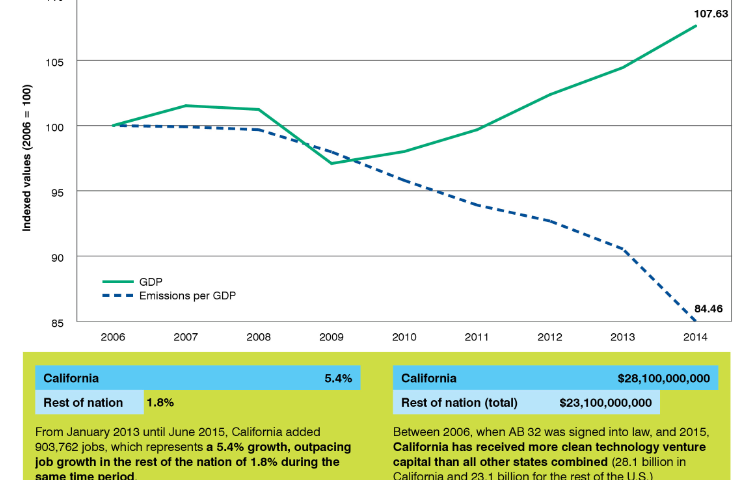California made history a decade ago this month by being first in the nation to pass legislation (AB 32) putting an absolute limit on carbon pollution through 2020.
The California Legislature made history again last week by extending and strengthening those limits to 2030 (SB 32 and AB 197). SB 32 requires California to reduce pollution 40% below 1990 levels by 2030 – as ambitious as Europe’s climate policies – and provides the flexibility to use a variety of tools to accomplish this goal. The governor has announced he will sign both bills.

Photo credit: Joseph Thornton | Flickr.com
Legislators also passed a spending plan yesterday that will direct approximately $900 million in cap-and-trade proceeds to reduce pollution and benefit California communities, especially the most disadvantaged. Another bill passed yesterday, AB 1550, increases the commitments of those disadvantaged communities and makes low-income communities beneficiaries as well.
California’s decision to set these new targets and establish this new spending plan was not just based on hope and necessity, but on a 10-year foundation of success and a solid understanding that this next set of targets are ambitious but achievable.
Here’s why California’s climate program has been a success, and why the new long-term emissions reduction target will help the state continue to thrive.
California’s carbon pollution is declining.
AB 32 requires California reduce its greenhouse gas emissions to 1990 levels by 2020, a reduction estimated at about 15% below where emissions would have been without regulation. To meet these reductions, California has adopted a suite of climate policies anchored by a cap-and-trade program, which puts an absolute limit on carbon pollution, while providing cost-effective options for businesses to meet their reduction obligations.
California’s carbon pollution has steadily declined in the last 10 years. In the first two years that the cap-and-trade system was in place (2013 and 2014), California’s carbon emissions declined by an amount equivalent to taking over 1 million passenger vehicles off the road for a year.
California is ahead of schedule in meeting its 2020 goal. Emissions have been below required levels in every year we have data for. Regulators expect that in 2020 California will exceed its own requirements by an amount that is equivalent to taking 3.3 coal burning power plants off-line for one year.
California’s economy is growing.
Historically economic growth has been accompanied by a corresponding increase in emissions, but California is charting a different course. The state’s Gross State Product has increased steadily since the recession as emissions have continued to fall, as shown in this figure:

In the first two and a half years of California’s groundbreaking carbon market, the state added over 900,000 jobs, a growth rate that eclipsed the national rate.
Carbon markets are going global.
The impressive outcomes from the first decade of California’s AB 32 implementation have attracted numerous partners. States, provinces, cities and countries are taking note and action.
At the Paris negotiations at the end of 2015, California Governor Jerry Brown showcased a “Memorandum of Understanding,” bringing together states and regions committing to reducing greenhouse gas emissions to at least 80% below 1990 levels by 2050, or to less than 2 metric tons per capita by 2050. Over 100 states, provinces, and cities, representing one quarter of the world economy, signed on the agreement.
In addition, California is partnering directly with several Canadian provinces to implement joint cap-and-trade programs. It has also established an agreement to share information and work with China and Mexico on their carbon pricing efforts.
2030 target is ambitious but achievable.
Estimates suggest that after on-the-books polices are implemented, California will still have to find a way to reduce pollution another 17-29 percent to meet the 2030 target. The Air Resources Board has proposed relying on a ratcheting up of existing polices and a reliance on the existing cap-and-trade program to ensure the 2030 target is met. Research from the Lawrence Berkeley National Laboratories shows that meeting the 2030 target is possible with a ratcheting up of existing polices
The world will be watching whether California can repeat its gold medal performance under these new targets, and all indicators seem to point in the state’s favor.
Enviroshop is maintained by dedicated NetSys Interactive Inc. owners & employees who generously contribute their time to maintenance & editing, web design, custom programming, & website hosting for Enviroshop.
